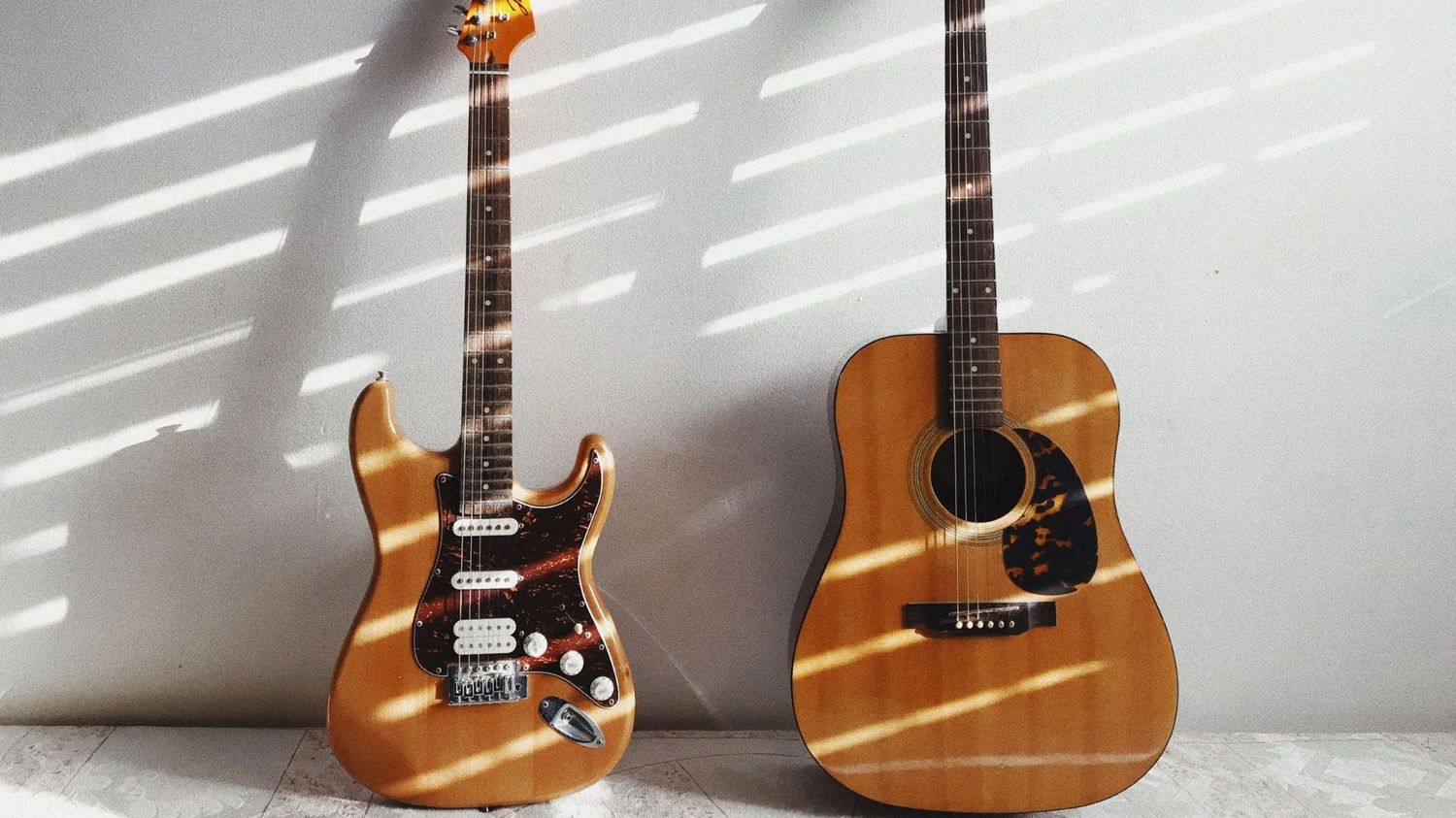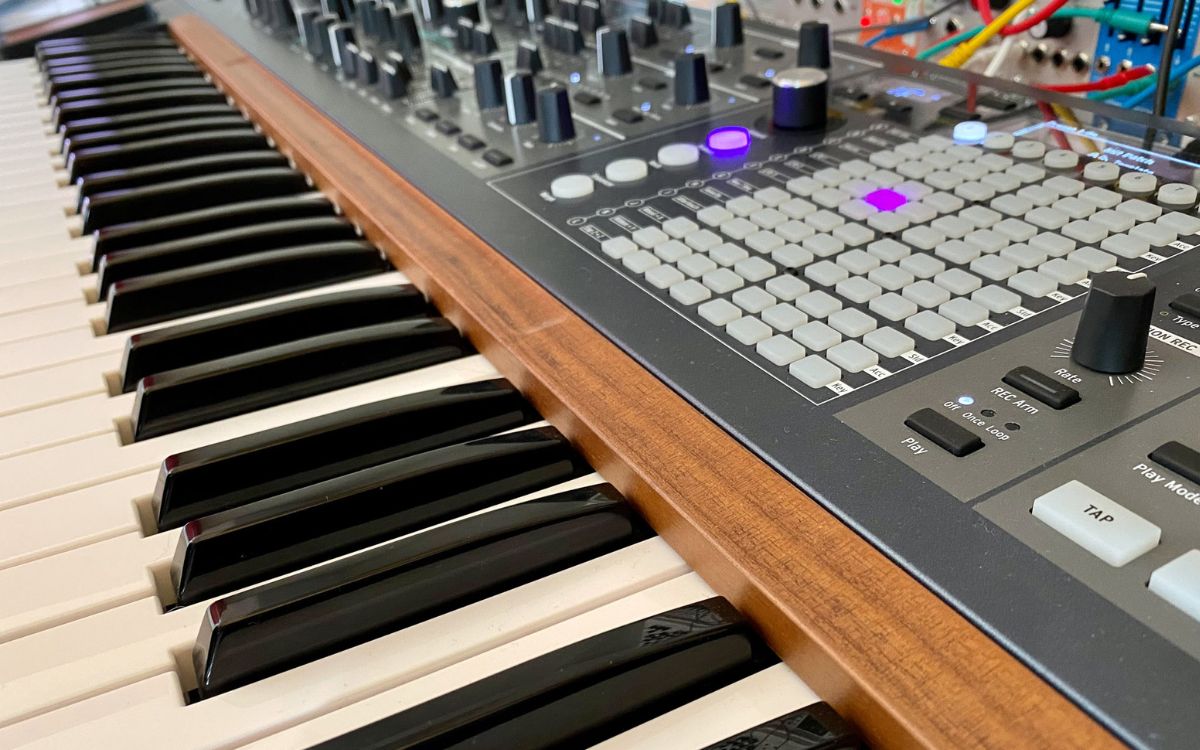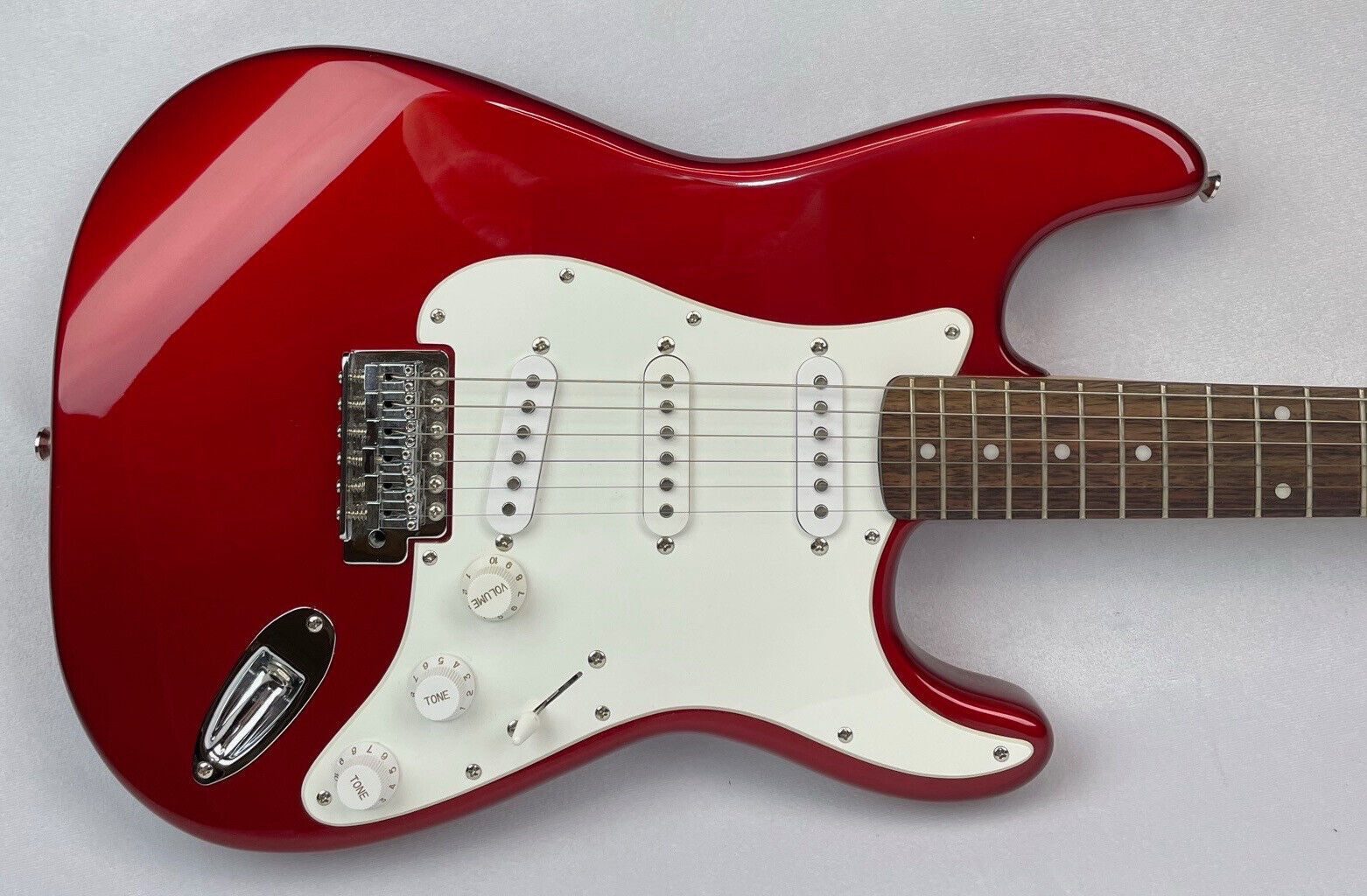Home>Production & Technology>Acoustic>What Is The Difference Between Electric Guitar And Acoustic Guitar


Acoustic
What Is The Difference Between Electric Guitar And Acoustic Guitar
Published: March 12, 2024
Discover the key contrasts between electric and acoustic guitars. Learn about their unique features, sounds, and playing styles to make an informed choice.
(Many of the links in this article redirect to a specific reviewed product. Your purchase of these products through affiliate links helps to generate commission for AudioLover.com, at no extra cost. Learn more)
Table of Contents
Introduction
When it comes to the world of music, the guitar holds a special place in the hearts of musicians and enthusiasts alike. Its versatility, expressive capabilities, and timeless appeal have made it a staple in various music genres. However, within the realm of guitars, there are distinct categories that cater to different playing styles and sonic preferences. Two prominent members of this musical family are the electric guitar and the acoustic guitar. While both instruments share the same fundamental purpose of creating beautiful music, they possess unique characteristics that set them apart.
The electric guitar, with its sleek and often eye-catching design, is renowned for its ability to produce a wide range of sounds, from gentle melodic tones to powerful, distorted riffs. In contrast, the acoustic guitar, with its classic wooden construction and resonant sound, offers a more organic and intimate musical experience. Understanding the differences between these two iconic instruments can deepen one's appreciation for their individual qualities and the music they inspire.
In this article, we will delve into the distinct features of electric and acoustic guitars, exploring their construction and design, sound and tone, amplification, playing techniques, and portability and convenience. By shedding light on these aspects, we aim to provide a comprehensive understanding of the unique characteristics and capabilities of electric and acoustic guitars. Whether you are a seasoned musician, an aspiring guitarist, or simply a music enthusiast, this exploration will offer valuable insights into the fascinating world of guitars and the diverse sonic landscapes they help create.
Construction and Design
The construction and design of electric and acoustic guitars are fundamental to their distinct characteristics and playing experiences. Understanding the differences in their physical makeup can provide valuable insights into how these instruments produce sound and feel in the hands of musicians.
Electric Guitar
Electric guitars are crafted with a solid body or a semi-hollow body, typically made of wood such as mahogany, alder, or maple. The solid body design minimizes feedback and allows for greater sustain, making it well-suited for various playing styles, especially those involving high-gain amplification. The sleek, contoured shape of electric guitars not only contributes to their aesthetic appeal but also enhances playability, allowing for easy access to higher frets.
One of the defining features of electric guitars is the presence of electromagnetic pickups, which capture string vibrations and convert them into electrical signals. These signals are then transmitted to an amplifier, where they are transformed into audible sound. The pickups, often positioned near the bridge and neck of the guitar, play a crucial role in shaping the instrument's tonal characteristics, offering a wide range of sonic possibilities through different pickup configurations and settings.
Additionally, electric guitars commonly feature a variety of controls, including volume and tone knobs, pickup selectors, and sometimes additional switches for coil tapping or phase reversal. These controls empower players to fine-tune their sound, experiment with different tonal textures, and unleash the full sonic potential of the instrument.
Acoustic Guitar
In contrast, acoustic guitars are characterized by their hollow body, which serves as a natural amplifier for the vibrating strings. The soundboard, typically made of spruce, cedar, or mahogany, plays a pivotal role in projecting the instrument's acoustic resonance and tonal richness. The shape and bracing of the guitar's body also significantly influence its sound, with different body styles, such as dreadnought, concert, and parlor, offering distinct tonal profiles and projection capabilities.
The design of acoustic guitars prioritizes acoustic resonance and projection, leading to features such as a soundhole, which allows the soundboard to vibrate freely and release the sound waves into the surrounding space. The bridge and saddle, responsible for transmitting string vibrations to the soundboard, are meticulously designed to optimize the transfer of energy and sustain, contributing to the instrument's overall sonic character.
Furthermore, acoustic guitars often incorporate decorative elements such as rosettes, binding, and inlay work, adding visual flair to their aesthetic appeal. The choice of tonewoods, the craftsmanship of the instrument's body, and the precision of its construction all play a crucial role in shaping the acoustic guitar's tonal nuances and playing experience.
In essence, the construction and design of electric and acoustic guitars not only influence their physical appearance but also define their sonic capabilities and playing dynamics. These distinctive attributes contribute to the allure of each instrument, catering to the diverse preferences and creative expressions of musicians across the globe.
Sound and Tone
The sound and tone of a guitar are perhaps the most defining aspects of its personality. When comparing electric and acoustic guitars, it becomes evident that their sound and tonal characteristics are shaped by distinct mechanisms, resulting in vastly different sonic experiences.
Electric Guitar
Electric guitars are renowned for their versatility in sound production, offering a wide spectrum of tones that can range from clean and mellow to aggressive and distorted. The unique sonic palette of electric guitars is primarily attributed to the interaction between the instrument's pickups, amplification, and signal processing.
The electromagnetic pickups of electric guitars play a pivotal role in capturing the vibrations of the strings and translating them into electrical signals. These signals are then channeled through cables to amplifiers, where they undergo further shaping and enhancement. The use of effects pedals, amplifiers, and equalization allows electric guitarists to sculpt their desired tones, adding layers of distortion, modulation, and ambience to create a rich and diverse sonic landscape.
Furthermore, the position of the pickups on the guitar significantly influences the instrument's tonal characteristics. The bridge pickup tends to produce a brighter, more aggressive sound, ideal for lead guitar work and cutting through dense musical arrangements. In contrast, the neck pickup delivers a warmer, rounder tone, well-suited for expressive solos and lush rhythm playing. Additionally, the combination of both pickups, along with various switching options, provides electric guitarists with a wide array of tonal possibilities, empowering them to tailor their sound to suit different musical contexts.
Acoustic Guitar
In contrast, the acoustic guitar relies on the natural resonance and projection of its hollow body to produce sound. The vibrations of the strings are transmitted through the bridge to the soundboard, where they resonate and amplify, creating a rich, organic acoustic tone. The tonal characteristics of an acoustic guitar are heavily influenced by the choice of tonewoods, body shape, and construction techniques.
Different tonewoods, such as spruce, cedar, and mahogany, impart distinct sonic qualities to acoustic guitars. For example, spruce is known for its bright and articulate sound, making it a popular choice for the soundboard of acoustic guitars. Cedar, on the other hand, produces a warmer, more mellow tone, ideal for fingerstyle playing and intimate performances. The body shape of an acoustic guitar also contributes to its tonal profile, with larger bodies offering enhanced bass response and projection, while smaller bodies emphasize clarity and articulation.
Moreover, the use of various playing techniques, such as fingerpicking, strumming, and percussive tapping, further enriches the tonal versatility of acoustic guitars, allowing musicians to evoke a wide range of emotions and moods through their playing.
In essence, the sound and tone of electric and acoustic guitars reflect their distinct sonic identities, offering musicians a diverse range of expressive possibilities. Whether it's the searing leads of an electric guitar or the intimate resonance of an acoustic guitar, each instrument carries its own unique voice, enriching the musical landscape with its sonic character.
Amplification
Amplification plays a crucial role in shaping the sonic characteristics and performance capabilities of electric and acoustic guitars. While both instruments rely on amplification to enhance their sound, the methods and technologies involved in the amplification process differ significantly, contributing to distinct sonic experiences for musicians and audiences.
Electric Guitar
Electric guitars are inherently designed to be paired with amplifiers, allowing for the electrification and amplification of their sound. The electric guitar's pickups, which convert string vibrations into electrical signals, serve as the starting point for the amplification journey. These signals are then transmitted through cables to amplifiers, where they undergo further processing and enhancement.
The amplifier, often equipped with tone controls, gain settings, and effects loops, serves as a sonic playground for electric guitarists, enabling them to shape their desired tones and textures. From clean, crystalline tones to searing, overdriven distortion, the amplifier acts as a canvas for sonic exploration, allowing musicians to unleash their creativity and expressiveness.
In addition to traditional amplifiers, electric guitarists often utilize a wide array of effects pedals to further sculpt their sound. These pedals, ranging from overdrive and delay to modulation and reverb, offer a diverse palette of sonic colors, enabling guitarists to craft unique and captivating tones that complement their musical vision.
Acoustic Guitar
In the case of acoustic guitars, amplification serves the purpose of enhancing the instrument's natural acoustic sound, allowing it to be heard clearly in live performance settings and larger venues. Acoustic guitar amplification can be achieved through various means, including acoustic amplifiers, acoustic preamps, and acoustic pickups.
Acoustic amplifiers are specifically designed to faithfully reproduce the natural sound of acoustic guitars, often featuring specialized input channels, EQ controls tailored for acoustic instruments, and built-in reverb and chorus effects to enhance the instrument's sonic presence.
Acoustic preamps, on the other hand, provide a means of shaping and refining the acoustic guitar's signal before it reaches the amplifier or sound system. These preamps offer control over tonal shaping, feedback suppression, and signal processing, ensuring that the instrument's unique acoustic qualities are accurately conveyed in a live or studio environment.
Furthermore, acoustic pickups, whether in the form of undersaddle transducers, soundboard transducers, or magnetic soundhole pickups, capture the vibrations of the acoustic guitar's strings and convert them into electrical signals for amplification. These pickups are essential for translating the instrument's acoustic resonance into a clear and balanced amplified sound, preserving the nuances of the guitar's tonal character.
In essence, amplification serves as a vital bridge between the inherent sound of electric and acoustic guitars and their audience. Whether it's the boundless sonic exploration of electric guitar amplification or the faithful reproduction of acoustic guitar sound, the amplification process plays a pivotal role in bringing the unique voices of these instruments to life in a myriad of musical settings.
Playing Technique
The playing technique employed on electric and acoustic guitars not only reflects the stylistic preferences of musicians but also significantly impacts the sonic characteristics and expressive capabilities of the instruments. From the nuanced fingerstyle approach to the high-energy techniques of rock and metal, the playing techniques associated with electric and acoustic guitars contribute to the rich tapestry of musical expression.
Electric Guitar
Electric guitar playing techniques encompass a wide array of styles, each with its own distinct sonic and expressive qualities. The use of a guitar pick, often made of plastic, metal, or other materials, is a hallmark of electric guitar playing, offering precision, speed, and attack for genres such as rock, blues, and metal. The dynamic range of electric guitar playing techniques includes:
-
Alternate Picking: This technique involves using a guitar pick to strike the strings both on the downstroke and the upstroke, allowing for rapid and precise note articulation. It is commonly employed in lead guitar playing and intricate rhythm patterns.
-
Legato: Utilizing techniques such as hammer-ons and pull-offs, legato playing on the electric guitar emphasizes smooth, connected notes, creating fluid and expressive melodic lines. This technique is often associated with virtuosic soloing and melodic improvisation.
-
Tapping: Popularized by virtuoso guitarists, tapping involves using the fingers of the picking hand to fret notes on the fretboard, creating rapid and intricate patterns. This technique unlocks a wide range of melodic and harmonic possibilities, enabling guitarists to achieve dazzling displays of technical prowess.
-
Bending and Vibrato: Electric guitarists often employ bending and vibrato techniques to infuse their playing with emotive and expressive qualities. Bending strings to alter pitch and applying controlled vibrato techniques add depth and character to individual notes, allowing for soulful and evocative performances.
Acoustic Guitar
The acoustic guitar, with its rich tonal resonance and intimate character, lends itself to a diverse set of playing techniques that highlight its acoustic qualities and expressive potential. From delicate fingerpicking patterns to percussive strumming styles, acoustic guitar playing techniques encompass a broad spectrum of musical expression:
-
Fingerpicking: This technique involves plucking the strings with the fingertips or fingernails, allowing for intricate and melodic patterns that evoke a wide range of emotions. Fingerpicking is widely used in folk, blues, and acoustic singer-songwriter genres, offering a nuanced and evocative approach to guitar playing.
-
Strumming and Rhythm Patterns: Acoustic guitarists often employ various strumming patterns and rhythmic techniques to drive the pulse of a song, providing a foundation for vocal accompaniment or instrumental arrangements. The use of percussive strumming, chord embellishments, and rhythmic dynamics adds depth and energy to acoustic performances.
-
Hybrid Picking: Combining elements of fingerpicking and flatpicking, hybrid picking allows acoustic guitarists to blend the warmth of fingerstyle playing with the precision and attack of using a pick. This technique enables the simultaneous plucking of strings and strumming with a pick, offering a versatile approach to melodic and rhythmic expression.
-
Tapping and Percussive Techniques: Acoustic guitarists often incorporate tapping and percussive techniques, such as body slaps, string slaps, and percussive strumming, to add rhythmic complexity and dynamic textures to their playing. These techniques enhance the rhythmic drive and sonic diversity of acoustic guitar performances.
In essence, the playing techniques associated with electric and acoustic guitars embody the diverse musical traditions and creative expressions of guitarists worldwide. Whether it's the searing leads and technical wizardry of electric guitar playing or the intimate resonance and emotive storytelling of acoustic guitar techniques, each instrument offers a unique canvas for musicians to explore and innovate, enriching the musical landscape with their distinct sonic personalities.
Portability and Convenience
Portability and convenience are essential considerations for musicians, influencing the practicality and accessibility of electric and acoustic guitars in various contexts, from live performances to casual jam sessions and travel scenarios. The differences in portability and convenience between electric and acoustic guitars stem from their distinct physical attributes and amplification requirements, shaping the ways in which musicians engage with and transport these instruments.
Electric Guitar
Electric guitars, with their solid or semi-hollow body designs, often feature a sleek and ergonomic form factor that lends itself to ease of handling and maneuverability. The relatively compact nature of electric guitars, coupled with their lighter weight compared to acoustic guitars, makes them well-suited for musicians seeking mobility and on-stage agility. Additionally, the absence of a large hollow body contributes to a more streamlined and manageable instrument, allowing electric guitarists to navigate crowded stages and performance spaces with greater ease.
In terms of amplification, electric guitars rely on external amplifiers and sound systems to project their sound, which can impact their overall portability. While the guitar itself may be relatively compact, the need to transport amplifiers, effects pedals, and associated equipment adds a layer of logistical considerations for electric guitarists, particularly in larger performance settings. However, advancements in amplifier technology, such as compact and lightweight amplifier heads and digital modeling solutions, have contributed to enhanced portability and convenience for electric guitarists, offering powerful sound reinforcement in a more manageable form.
Acoustic Guitar
Acoustic guitars, characterized by their hollow body construction and natural acoustic projection, present a different set of considerations in terms of portability and convenience. The larger body size of acoustic guitars, particularly in the case of dreadnought and jumbo body styles, can pose challenges in terms of transport and maneuverability, especially in confined spaces or during travel. However, the acoustic guitar's self-contained amplification requirements, often facilitated through acoustic amplifiers or portable PA systems, contribute to a more streamlined and self-sufficient setup for live performances and rehearsals.
Moreover, the acoustic guitar's ability to deliver a full-bodied sound without the need for external amplification makes it an inherently convenient instrument for impromptu performances, acoustic gatherings, and outdoor settings. Its acoustic resonance and portability make it a versatile companion for musicians seeking to share their music in intimate settings or on the go, without the logistical considerations associated with electric guitar amplification.
In essence, the portability and convenience of electric and acoustic guitars are influenced by a combination of physical design, amplification requirements, and practical considerations for musicians. While electric guitars offer streamlined instrument designs and evolving amplifier technologies for on-stage mobility, acoustic guitars embody self-contained acoustic projection and versatile portability for diverse musical settings. Understanding these nuances allows musicians to make informed choices based on their specific performance needs and creative preferences, ensuring that their musical journey is supported by instruments that seamlessly integrate into their musical lifestyle.
Conclusion
In conclusion, the distinction between electric and acoustic guitars extends far beyond their sonic characteristics, encompassing their construction, amplification, playing techniques, and portability. Electric guitars, with their solid or semi-hollow body designs, electromagnetic pickups, and versatile amplification options, offer a boundless sonic playground for musicians seeking a wide range of tones and textures. The expressive techniques associated with electric guitar playing, from intricate alternate picking to soul-stirring vibrato, underscore the instrument's dynamic and versatile nature, making it a staple in genres ranging from rock and blues to jazz and metal.
On the other hand, acoustic guitars, with their hollow body construction, natural acoustic resonance, and self-contained amplification requirements, embody a timeless and intimate musical experience. The diverse playing techniques associated with acoustic guitar, including fingerpicking, percussive strumming, and hybrid picking, showcase the instrument's ability to evoke a spectrum of emotions and moods, making it a cherished companion for singer-songwriters, folk musicians, and acoustic enthusiasts worldwide.
The distinct construction and design of electric and acoustic guitars, from the sleek contours of electric guitars to the ornate craftsmanship of acoustic instruments, reflect their individual sonic identities and visual appeal. The amplification process, whether it involves sculpting tones through effects pedals and amplifiers for electric guitars or faithfully reproducing acoustic resonance through acoustic amplifiers and pickups for acoustic guitars, plays a pivotal role in shaping the instruments' sonic presence in live and studio settings.
Furthermore, the portability and convenience considerations associated with electric and acoustic guitars underscore the practical aspects of engaging with these instruments in various musical contexts. While electric guitars offer streamlined designs and evolving amplifier technologies for on-stage mobility, acoustic guitars embody self-contained acoustic projection and versatile portability for impromptu performances and intimate gatherings.
Ultimately, the distinction between electric and acoustic guitars enriches the musical landscape by offering diverse sonic palettes, expressive possibilities, and practical considerations for musicians. Whether it's the searing leads and technical wizardry of electric guitar playing or the intimate resonance and emotive storytelling of acoustic guitar techniques, each instrument carries its own unique voice, contributing to the rich tapestry of musical expression and creativity.











